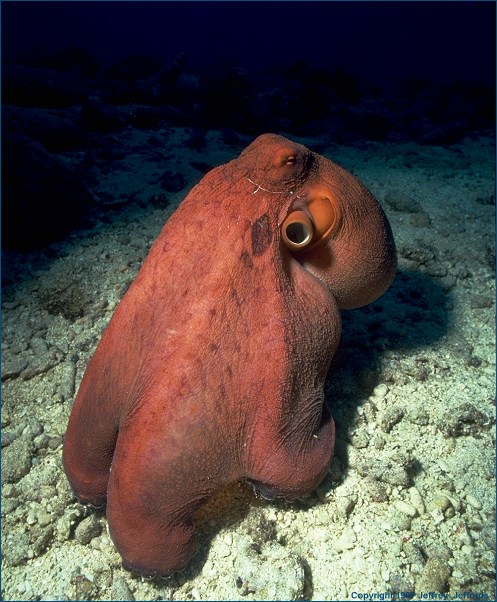
Photo courtesy of: Jeff's Nudibranch and Coral Reef Gallery |

Photo courtesy of: Jeff's Nudibranch and Coral Reef Gallery |
| Name: Pacific Octopus |
| Scientific name: Octopus dofleini |
| Range: Northern Asia to California |
| Habitat: Ocean floor |
| Status: Not threatened |
| Diet in the wild: Crabs, crayfish and other various bivalves |
| Diet in the zoo: Crabs, crayfish and other various bivalves |
| NOTE:
This Animal is Not Currently on Exhibit |
| Physical description: Weight 60 kilograms. Body length up to 25 feet. Color comes in different dark colors. Head consists of the eyes and a brain with 30 noticeable lobes. The lobes function in sight and appearance of certain objects. Eight, long, sucker covered arms of equal length. Buccal cavity contains jaw like radula. Body is globular and contains no fins. |
| General
information:
No species of octopuses have shells. Octopuses hunt down anything that is vulnerable, killing their prey by injecting poison from their salivary glands. They have a short life span and only mingle once with others for copulation. These octopuses are huge in size only after a year of living. The dofleini come in various dark colors. They also have the ability to change colors and shape. Females can only mate with mature males to produce offspring that are the size of a flea. Octopus can regenerate any part of its body in six weeks when an amputation occurs, but becomes smaller than its original size. Many of these marvelous creatures have good eyesight, but can not see in color. Little is known about the abundance, distribution, and population trends of octopus. |

Jeff's Nudibranch and Coral Reef Gallery |
| Octopus Locomotion:
Octopus move by use of their mantles.
The mantle cavity is used in breathing and locomotion. The mantle musculature
acts as a control knob for water movement in and out of the mantle cavity.
With this, the octopus can propel through the water with ease.
|
| Special
anatomical, physiological or behavioral adaptations:
They change color, flee, or project a smoke screen of brownish fluid when threatened. Behavioral adaptations can be obtained by observing others. They can be taught to perform tasks and solve problems. |
| Comments
about the octopus from the Fort Worth Zoo:
The octopus have a set life. They had a female octopus dofleini last year, but she died full of eggs. When the female octopuses give off offspring they die shortly after. They fed this particular octopus blue crabs, shrimp and caplain. They tried to feed this octopus the crabs live, but they ended up thawing them out because she wouldn't eat them. This octopus was kept in a tank by herself because they are expensive animals to buy for aquarium purposes. The aquarium usually buys these animals at small ages because of their short lived lives. Their dofleini couldn't lay her eggs and ended up dying last year. |
| Learning
In Octopuses:
When two octopuses were placed in an experiment in which two octopuses had to decipher between a red ball and a white ball, one octopus repeatedly picked the wrong colored ball. The second octopus was placed in a separate tank in which he could observe his friend. When it was the second octopuses turn he picked the correct ball every time. This tells us that octopuses are good observers and are very smart when it comes to problem solving.
|
|
http://marine.alaskapacific.edu/octopus/ |
| Personal Observations:
The Forth Zoo currently does not have these octopuses
on display, so I could not do any observations.
|
| Source
Materials and Related Links:
The Cephalopod Page!
"The giant octopus"
Jeff's Nudibranch and Dive Gallery http://www.hmsc.orst.edu/odfw/devfish/sp/octo.html Giant Pacific Octopus:http://www.pwssc.gen.ak.us/pwssc/staff/scheel.hard/octopus.html "No Mother Could Give More:"
|
|
Sarah Salman mailto: sarsradish@yahoo.com |